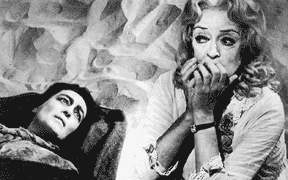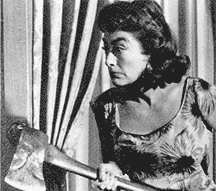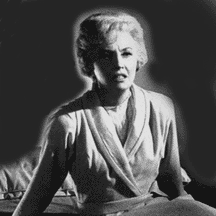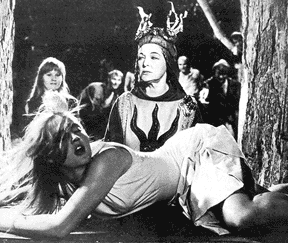Send in the Crones: Older Women Stars in Contemporary Gothics, 1962–1976
Most horror films have a theme or subtext about the past—personal, historical, evolutionary—invading the present. In the post-studio era of American film, that theme took an odd turn as aging Hollywood stars, particularly women, were used as monsters or victims in a series of gothic thrillers.
The pioneers in this cycle comprise an impressive roster of fame and power from the classic era: Bette Davis, Joan Crawford, Barbara Stanwyck, Olivia de Havilland—all Oscar winners or nominees in their heyday. Other respected actors made contributions to horror in this period: Tallulah Bankhead, Veronica Lake, Debbie Reynolds, Lana Turner, Shelley Winters, Agnes Moorehead, Deborah Kerr, Ava Gardner, and others.
Most of these films were decidedly downscale. Most of the roles were less than rewarding, eventually settling into two predictable types, the malevolent granny or the terrorized matron. Still, this subgenre can be tracked for more than a decade, keeping gothic traditions alive in lean times, starting in the wake of Psycho (1960) and ending finally when Halloween (1978) turned the duties of screaming and dying over to teenagers.
 Today’s jaded audience can only imagine the impact Psycho had on suspense and horror genres and on American film in general. With one low-budget effort, Alfred Hitchcock said goodbye to the old Hollywood, nailed shut the coffin of censorship, and raised the standards of suspense, realistic violence and psychological intensity for all dramatic films thereafter. To the old-time Hollywood stars, the abrupt knifing of glamour queen Janet Leigh in the “shower scene” might have been an ominous signal: in the new Hollywood, they were expendable.
Today’s jaded audience can only imagine the impact Psycho had on suspense and horror genres and on American film in general. With one low-budget effort, Alfred Hitchcock said goodbye to the old Hollywood, nailed shut the coffin of censorship, and raised the standards of suspense, realistic violence and psychological intensity for all dramatic films thereafter. To the old-time Hollywood stars, the abrupt knifing of glamour queen Janet Leigh in the “shower scene” might have been an ominous signal: in the new Hollywood, they were expendable.
In the 1930s and 1940s, actors were nurtured and sheltered by the studio system, and some learned to use that system for their own advancement. But by 1960 the once-powerful studios were primarily distribution companies, supplanted by independent producers, and actors were cut loose to make their own deals. It was a harsh environment for their trade, too. Movie attendance had dropped to half its 1940s peak, and marketing focus was shifting to young viewers who barely recognized the old players.
 A comically frustrated ad appeared in the Hollywood Reporter under the heading “Situations Wanted, Women/Artists” on September 21, 1962: “Mother of three—10, 11 & 15—divorcée. American. Thirty years experience as an actress in motion pictures. Mobile still and more affable than rumor would have it. Wants steady employment in Hollywood (has had Broadway).”
A comically frustrated ad appeared in the Hollywood Reporter under the heading “Situations Wanted, Women/Artists” on September 21, 1962: “Mother of three—10, 11 & 15—divorcée. American. Thirty years experience as an actress in motion pictures. Mobile still and more affable than rumor would have it. Wants steady employment in Hollywood (has had Broadway).”
The tongue-in-cheek advertiser was Bette Davis. The Oscar-winning star was suffering a shortage of opportunities for nearly a decade since her triumph in All About Eve (1950). But by the time the ad was published, her new career track was already established, and her breakthrough film was about to be released. Whatever Happened to Baby Jane? debuted on November 6, 1962.
Davis is the title character, an aging child star clinging to memories, plotting a comeback with the supposed support of scheming Victor Buono, an unconventional gigolo to say the least. Joan Crawford is the noble wheelchair-bound sister whose career once overshadowed Baby Jane’s. The film’s alleged shocks derive mainly from Davis’s torture of a captive Crawford, but what endures is the macabre performance by Davis, who transforms herself into a gargoyle in little-girl makeup, contrasted with Crawford’s theatrical suffering and Buono’s droll cynicism. Overall, I think the movie is too long, and the “surprise” ending is limp, but director Robert Aldrich shows a deft hand with black humor, and there are a number of good scenes.
This was Davis’s first teaming with Crawford, another award-winning actress whose most popular films were a decade or more in the past. Their behind-the-scenes rivalry during the making of this film is legendary, but it’s tough to sort out the real story from publicists’ inventions—after all, the film was designed to attract the morbidly curious, film fans eager to see two aging greats battle it out, and that weird spectacle was the focus of the promotion.
 Baby Jane was big box-office, and gathered a stack of Oscar nominations. Both Crawford and Davis capitalized on its success in separate series of grotesque suspense films. Their example inspired other veteran actors, almost all women, many of them “above the title” names, to try the field. My homemade filmography lists 23 horrific films after Baby Jane utilizing older female stars in a significant capacity. Scholarly fans might have more nominees for this category. Here, I’ll briefly discuss seven follow-up films from the early to mid-1960s, and perhaps someday MonsterZine will publish a sequel covering the rest of the cycle. Frankly, most of these films are out-of-print and tough to find—more on that later.
Baby Jane was big box-office, and gathered a stack of Oscar nominations. Both Crawford and Davis capitalized on its success in separate series of grotesque suspense films. Their example inspired other veteran actors, almost all women, many of them “above the title” names, to try the field. My homemade filmography lists 23 horrific films after Baby Jane utilizing older female stars in a significant capacity. Scholarly fans might have more nominees for this category. Here, I’ll briefly discuss seven follow-up films from the early to mid-1960s, and perhaps someday MonsterZine will publish a sequel covering the rest of the cycle. Frankly, most of these films are out-of-print and tough to find—more on that later.
Hush...Hush, Sweet Charlotte (1964) was intended by producer-director Aldrich as the direct follow-up to Baby Jane, featuring a re-teaming of Davis and Crawford. Alas, Crawford fell ill in the early filming, allegedly with pneumonia, allegedly aggravated by a frigid air-conditioned dressing room, the oppressive heat of the Louisiana location, and a steady diet of vodka. Olivia de Havilland took over the Crawford role but never seemed to completely join the fun. I suppose someone had to play straight to the excesses of Davis, as the aging southern belle who may or may not have dismembered Bruce Dern way back when, with Agnes Moorhead as an amusing maid, plus Joseph Cotten, Mary Astor and Victor Buono. The little scenery that this cast leaves unchewed creates a nicely decadent southern setting.
Joan Crawford was jealous of Davis’s Oscar nomination for Baby Jane, and her consolation prize was Strait-Jacket (1963), the story of a disoriented axe murderess released from the bin after 20 years to live with her daughter on a family farm. And you know what happens on a family farm when the family gets hungry for chicken. This twisted whodunit was fashioned by producer-director William Castle from a Robert Bloch screenplay. Castle was better known for showmanship than craftsmanship. In this movie, opportunities for suspense are routinely squandered, and no opportunity for a cheap shock effect is missed. But Crawford’s part abounds in opportunities for all-out acting, and she makes the most of them. She carries the film.
 The Night Walker (1964) was Barbara Stanwyck’s sole venture into the modern shocker, and she disliked the results so much that she retreated to The Big Valley. Her last theatrical film is more like a Mission Impossible episode than a TV western, however. Stanwyck is having vivid dreams which may or may not be real, featuring a “dream lover,” and she enlists real-life ex-husband Robert Taylor to help investigate. Taylor still looks good, but unfortunately for admirers of photogenic manhood, the “dream lover” turns out to be character actor Lloyd Bochner. Unfortunately for us all, William Castle is in charge again, showing his usual inability to rise above budget limitations, and the potential of the Robert Bloch script is wasted. Stanwyck is the film’s redeeming feature. She shows some of her old authority as she expands on her celebrated victim role from Sorry, Wrong Number (1948).
The Night Walker (1964) was Barbara Stanwyck’s sole venture into the modern shocker, and she disliked the results so much that she retreated to The Big Valley. Her last theatrical film is more like a Mission Impossible episode than a TV western, however. Stanwyck is having vivid dreams which may or may not be real, featuring a “dream lover,” and she enlists real-life ex-husband Robert Taylor to help investigate. Taylor still looks good, but unfortunately for admirers of photogenic manhood, the “dream lover” turns out to be character actor Lloyd Bochner. Unfortunately for us all, William Castle is in charge again, showing his usual inability to rise above budget limitations, and the potential of the Robert Bloch script is wasted. Stanwyck is the film’s redeeming feature. She shows some of her old authority as she expands on her celebrated victim role from Sorry, Wrong Number (1948).
More suspense than horror, Lady in a Cage (1964) is notable for the presence of Olivia de Havilland as the title character. She’s stuck in a caged elevator in her urban home, at the mercy of a sadistic gang of home invaders. De Havilland is fine in a chilly portrait of a too-common contemporary crime.
Die! Die! My Darling (1965, released in Britain as Fanatic) is more firmly within the gothic tradition. The unsettling innovation in this Richard Matheson story is that the monster is a deluded Christian. Tallulah Bankhead is so enraged to learn that Stefanie Powers fornicated with her late son that she locks the young woman up and gives her a dose of old-time religion, Inquisition style. The film drags the premise out a bit too long, but the supporting players are solid, and Bankhead is a treat. There’s the obligatory scene with the local clergyman who explains that real Christianity isn’t so harsh, but we all know what the message is here. Imagine this movie being shown on television these days—maybe as a holiday special in the Touched by an Angel time slot. I know I saw it on TV as a boy, on some carefree local station, and since I was raised among fundamentalists (and I was a big fan of The Girl From U.N.C.L.E.), you bet your life it had an impact.
 Another mind-blowing childhood experience was provided by Bette Davis in what may be the best performance of her later years, as The Nanny (1965). I saw this nail-biter on television when I was about the same age as the boy Davis was supposed to be nurturing. How I got away with watching this, I don’t know. All the adults in the film thought Master Joey drowned his sister, but Master Joey knew better, and when I saw Nanny filling the bathtub for Master Joey, I wished I were still in diapers. The movie is still powerful, an unusually tight, claustrophobic drama from Hammer Studios, and Davis is perfectly evil under her prissy facade. A must-see film from this list.
Another mind-blowing childhood experience was provided by Bette Davis in what may be the best performance of her later years, as The Nanny (1965). I saw this nail-biter on television when I was about the same age as the boy Davis was supposed to be nurturing. How I got away with watching this, I don’t know. All the adults in the film thought Master Joey drowned his sister, but Master Joey knew better, and when I saw Nanny filling the bathtub for Master Joey, I wished I were still in diapers. The movie is still powerful, an unusually tight, claustrophobic drama from Hammer Studios, and Davis is perfectly evil under her prissy facade. A must-see film from this list.
A year later, Hammer succeeded in recapturing only a portion of the tone of Jacques Tourneur’s Curse of the Demon (1956) in The Devil’s Own (1966, a.k.a. The Witches). The star was Joan Fontaine, no stranger to the gothic melodrama, as seen in Rebecca (1940) and Jane Eyre (1944). Fontaine is fine here as a schoolmistress in a sleepy English town investigating an evil coven. Not bad, but the Nigel Kneale script confuses African religion, witchcraft and Satanism, and none of these forces prove powerful enough to create effective thrills. Meanwhile, the cult members are so unattractive, the viewer prays to any available deity that they won’t disrobe for a ritual. Fontaine gave up on movies after this film, but its failings do not include her work or the glowering performance of coven leader Kay Walsh.
Fontaine’s trek into heck foreshadowed the Satanism trend of the ensuing decade that peaked with Rosemary’s Baby (1968) and The Exorcist (1973). Big-name actresses in 1970s horror would divide their screen time between terrorizing their families and ducking black-robed cultists.
So, whatever happened to the stars of Baby Jane?
Joan Crawford continued in low-budget thrillers, but never repeated the success of Baby Jane. She exhibited her well-preserved figure in tights in the circus murder mystery Berserk (1967), and unleashed a caveman in her final theatrical film Trog (1970). Her last great role was not in a film, but in the TV pilot episode of Night Gallery, portraying a blind art patron greedy for an eye transplant, under the direction of first-timer Steven Spielberg.
 Bette Davis finished out her career with more mainstream recognition, appearing in dull respectable vehicles such as Death on the Nile and The Whales of August and softcore Disney thrillers such as Return From Witch Mountain and Watcher in the Woods. Davis did a couple more gothic-family movies, too: The Anniversary (1968), as an eye-patched domineering mom; and an underdeveloped role in Burnt Offerings (1976) in which an evil house sends family members over the edge. Incidentally, Burnt Offerings was the first horror movie I ever saw properly in a theater, having had a movie-deprived childhood, and my one memory of the experience was my thought upon exiting: “Needs more Bette Davis.” The volatile star ended her career in fittingly rebellious fashion by walking off the set of Wicked Stepmother, a film with a self-explanatory title by exploitation director Larry Cohen. (A patch-up version of the film was released in 1989.)
Bette Davis finished out her career with more mainstream recognition, appearing in dull respectable vehicles such as Death on the Nile and The Whales of August and softcore Disney thrillers such as Return From Witch Mountain and Watcher in the Woods. Davis did a couple more gothic-family movies, too: The Anniversary (1968), as an eye-patched domineering mom; and an underdeveloped role in Burnt Offerings (1976) in which an evil house sends family members over the edge. Incidentally, Burnt Offerings was the first horror movie I ever saw properly in a theater, having had a movie-deprived childhood, and my one memory of the experience was my thought upon exiting: “Needs more Bette Davis.” The volatile star ended her career in fittingly rebellious fashion by walking off the set of Wicked Stepmother, a film with a self-explanatory title by exploitation director Larry Cohen. (A patch-up version of the film was released in 1989.)
By then, a new generation of horror filmmakers was on the job, director headliners who cranked grand guignol up a few notches in The Texas Chainsaw Massacre (1974), The Hills Have Eyes (1977) and Halloween (1978). Thereafter, the few older Hollywood stars who stayed with it were usually relegated to cameo roles in teen slasher flicks.
Most of the movies in this cycle were released on video in the 1980s to cash in on the horror boom of the time, but many have been out of print for a decade or more, only available from second-hand dealers at inflated prices. Why isn’t Bette Davis, at least, celebrated by horror fans? Maybe because fandom has traditionally been a boy’s world, disinterested in horror heroines who lack youthful sex appeal. Maybe these movies are not explicit enough to satisfy most young horror fans, while mature fans consider them embarrassing to their idols. Those few who take the trouble to seek out these films are typically looking for campy laughs.
But I think there is much to admire in the better films in this cycle—suspense, atmosphere, grotesque humor, a few genuine surprises—and even when the films are weak, there is much to admire in these stars. Rejected as too old for mainstream leading roles, sometimes saddled with outdated acting styles, these women were still capable of strong and even shocking performances. They showed enormous courage in putting these performances on film, and for that they deserve our applause.
